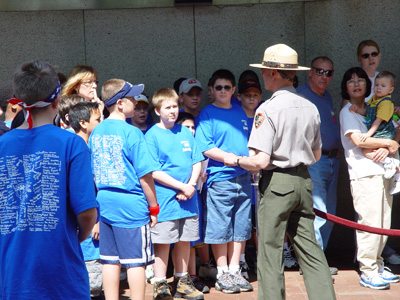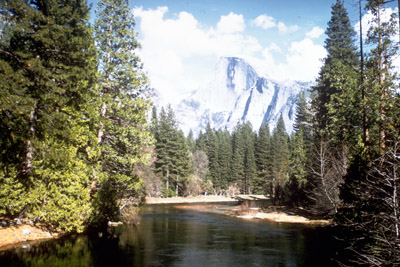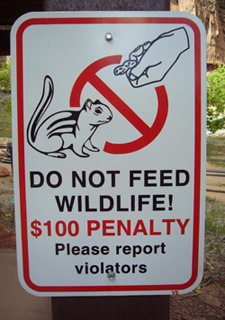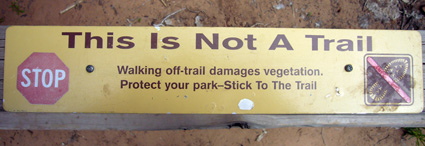
Parks suffer from their own popularity
“It’s just not the same,” Claudy Joseph, 23, from Sunrise, Fla., stated somberly.
Joseph has been visiting Northern California’s Yosemite National Park with his family every year for the past 20 years.
“The lines, the trampled trails, the trash, that is not how it used to be,” Joseph explained.
During the past 17 years, visitor attendance in the U.S. national parks has increased by 10 percent each year. The recent influx of visitors has brought with it a slew of issues the parks have never had to face before. Annual attendance is nearing an all-time high with about 285 million visitors in 2009.
“It’s a tough situation,” former Yosemite employee and University of Miami student Kateva Rosato said.
 |
At left, a National Park Service ranger talks with visitors. Below, scenery such as this view of Half Dome at Yosemite Valley in Yosemite National Park, is one of the reasons parks are popular (Photos courtesy of the National Park Service). Last, two park signs at Zion National Park reflect concerns about the impact of visitors on the park (Photos by Bruce Garrison). |
“There are just so many people, it’s hard to know what to do because we can’t follow behind every person to clean up the mess.”
Both pedestrian and vehicle traffic have led to erosion on the trails, trampled vegetation, litter, noise, smog and water pollution.
Yosemite Park Ranger and Spokesperson Kari Cobb noted the detriment to the park’s landscape from the visitors.
“When you have so many people, they are going to cause damage,” Cobb stated.
In essence, the national parks are suffering from their own popularity.
With an increase in both frequency and severity of physical damage, the amount of repair required is greater than ever before. Often times this proves to be a struggle with limited funds available, consequently resulting in insufficient, incomplete, or delayed reparations.
Wildlife is also threatened by increased numbers of visitors. The congestion of humans in their natural habitat causes stress to the animals which often times leads to injury.
 “One of the things some of the parks could do is sell portions of the park’s land to private owners to increase funding,” Rosato said. “It has its pros and cons because it lessens the area for a lot of animals and even increases the chances of spreading disease.
“One of the things some of the parks could do is sell portions of the park’s land to private owners to increase funding,” Rosato said. “It has its pros and cons because it lessens the area for a lot of animals and even increases the chances of spreading disease.
The most pressing park issue for visitors is definitely overcrowding in many of the popular parks.
“Even in the Everglades, there have been a ton of more people,” Florida native and Everglades regular Andrew Luer said. “It is not as easy and simple to go anymore.”
Parking and transportation stands to be one of the most impacted components of a guest’s visit. Due to the overcrowding, the roads surrounding the park, the designated parking areas, and especially the internal roads all face heavy and relentless traffic.
Yosemite has consolidated parking to one lot and implemented a shuttle system to transport visitors to the park, according to Scott Gediman, a Yosemite park spokesperson and ranger.
 Backups on the roads are caused not only because of the amount of cars, but also because often people stop their cars on the road to take photographs of the scenery or an animal, thus slowing the traffic even more.
Backups on the roads are caused not only because of the amount of cars, but also because often people stop their cars on the road to take photographs of the scenery or an animal, thus slowing the traffic even more.
In order to provide relief, Yosemite’s bus system has successfully cleared up traffic and made travel within Yosemite Valley much easier.
The issue at its core, the excess in visitors, only seems to be relieved through rationing strategies.
First-come, first-serve systems, price increases, and lotteries have all been enforced as methods of crowd control.
At Yosemite managers have implemented a permit system to limit the people on a trail per day.
This permit ensures that an appropriate number of visitors will take the trail so that the park is able to maintain environmental conditions.
According to Cobb, Yosemite is currently in the process of restoring it’s damaged Merced River, recording the number of visitors daily as of now, and determining how many visitors the area can handle.
Another contributing solution is to utilize more of the parks land and distribute the guests so that they are not all condensed in a few areas. Urging the visitors to spread out from the central attractions and venture to other areas proves to be a success method of crowd dispersion.
 Parks are in the process of implementing the strategies to ease traffic and crowding, focusing on both ensuring an enjoyable experience for guests and also the preservation of land.
Parks are in the process of implementing the strategies to ease traffic and crowding, focusing on both ensuring an enjoyable experience for guests and also the preservation of land.
“I would hate to see the parks get ruined,” Joseph said. “It’s great to hear that they’re working to figure it out. This is a tradition for my family, and I’m sure many others, that I want to continue for a while.”

Comments are Closed